Cost Analysis and Recommendations for Digital Solutions Inc.
VerifiedAdded on 2023/06/03
|8
|1190
|127
Case Study
AI Summary
This case study examines Digital Solutions Inc., a manufacturer of Voltage Regulators and Motherboards, focusing on cost analysis and pricing strategies. The analysis includes activity-based allocation of overhead costs, markup on full product cost, target cost per unit for a new voltage regulator, and achievements of cost reduction targets. The study identifies that the current overhead allocation method is inaccurate and proposes a refined approach based on activity cost pools and cost drivers such as machine setup, testing, and engineering. The recommendations emphasize shifting focus towards Motherboard sales due to their higher profit margin compared to Voltage Regulators, despite the company's efforts to reduce the Voltage Regulator's cost and set a competitive target price. The analysis also highlights the importance of accurate cost allocation for informed decision-making and improved profitability.
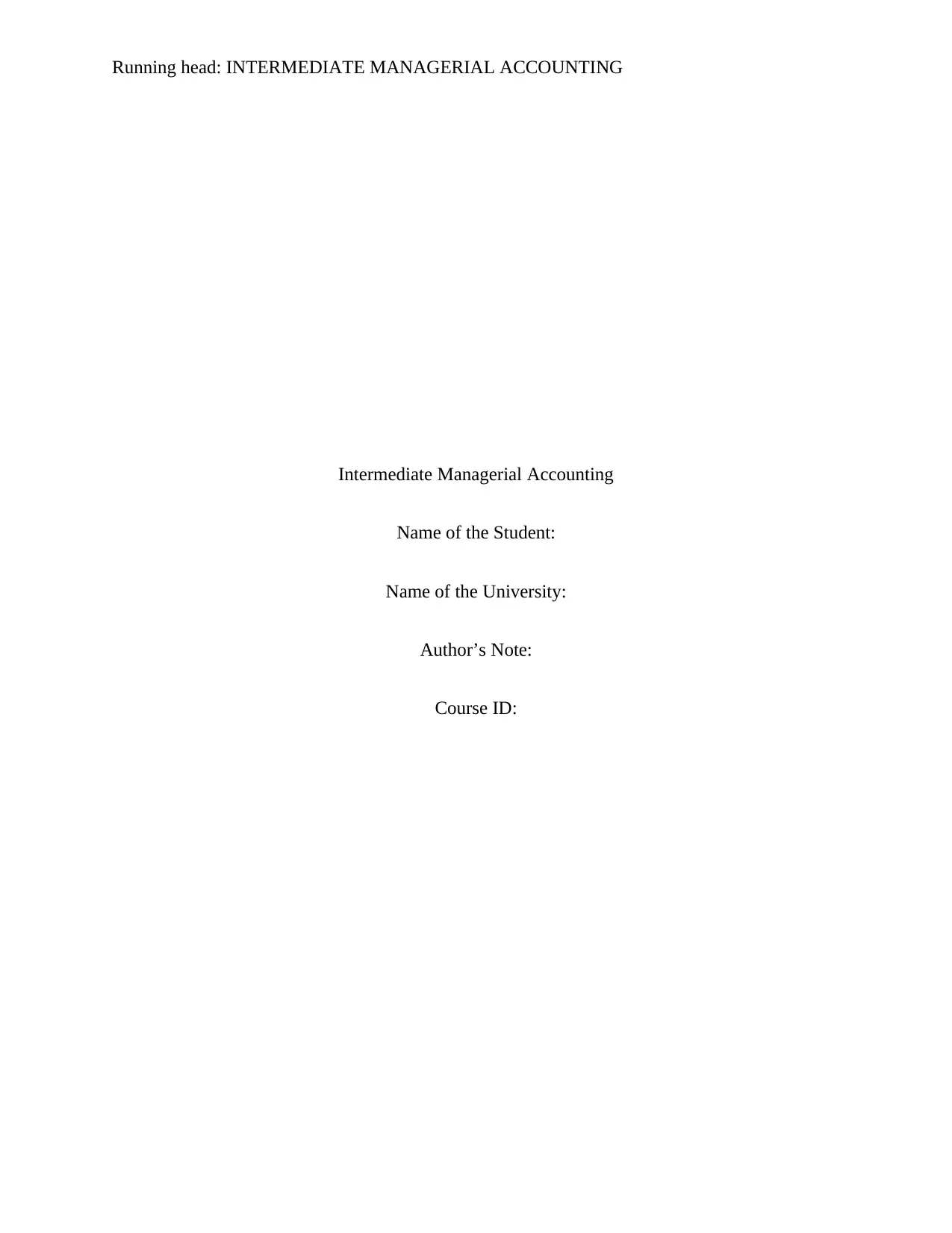
Running head: INTERMEDIATE MANAGERIAL ACCOUNTING
Intermediate Managerial Accounting
Name of the Student:
Name of the University:
Author’s Note:
Course ID:
Intermediate Managerial Accounting
Name of the Student:
Name of the University:
Author’s Note:
Course ID:
Paraphrase This Document
Need a fresh take? Get an instant paraphrase of this document with our AI Paraphraser
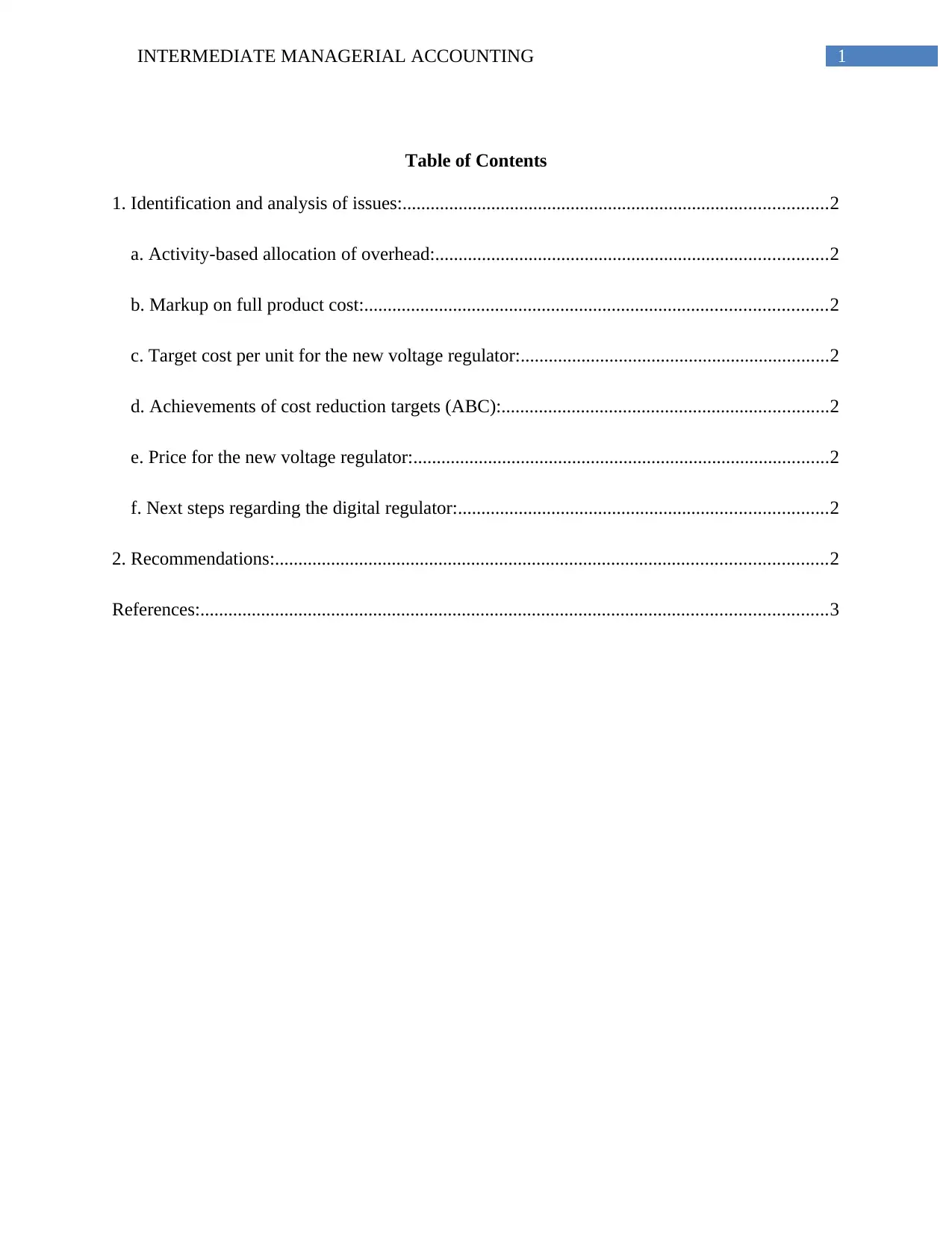
1INTERMEDIATE MANAGERIAL ACCOUNTING
Table of Contents
1. Identification and analysis of issues:...........................................................................................2
a. Activity-based allocation of overhead:....................................................................................2
b. Markup on full product cost:...................................................................................................2
c. Target cost per unit for the new voltage regulator:..................................................................2
d. Achievements of cost reduction targets (ABC):......................................................................2
e. Price for the new voltage regulator:.........................................................................................2
f. Next steps regarding the digital regulator:...............................................................................2
2. Recommendations:......................................................................................................................2
References:......................................................................................................................................3
Table of Contents
1. Identification and analysis of issues:...........................................................................................2
a. Activity-based allocation of overhead:....................................................................................2
b. Markup on full product cost:...................................................................................................2
c. Target cost per unit for the new voltage regulator:..................................................................2
d. Achievements of cost reduction targets (ABC):......................................................................2
e. Price for the new voltage regulator:.........................................................................................2
f. Next steps regarding the digital regulator:...............................................................................2
2. Recommendations:......................................................................................................................2
References:......................................................................................................................................3
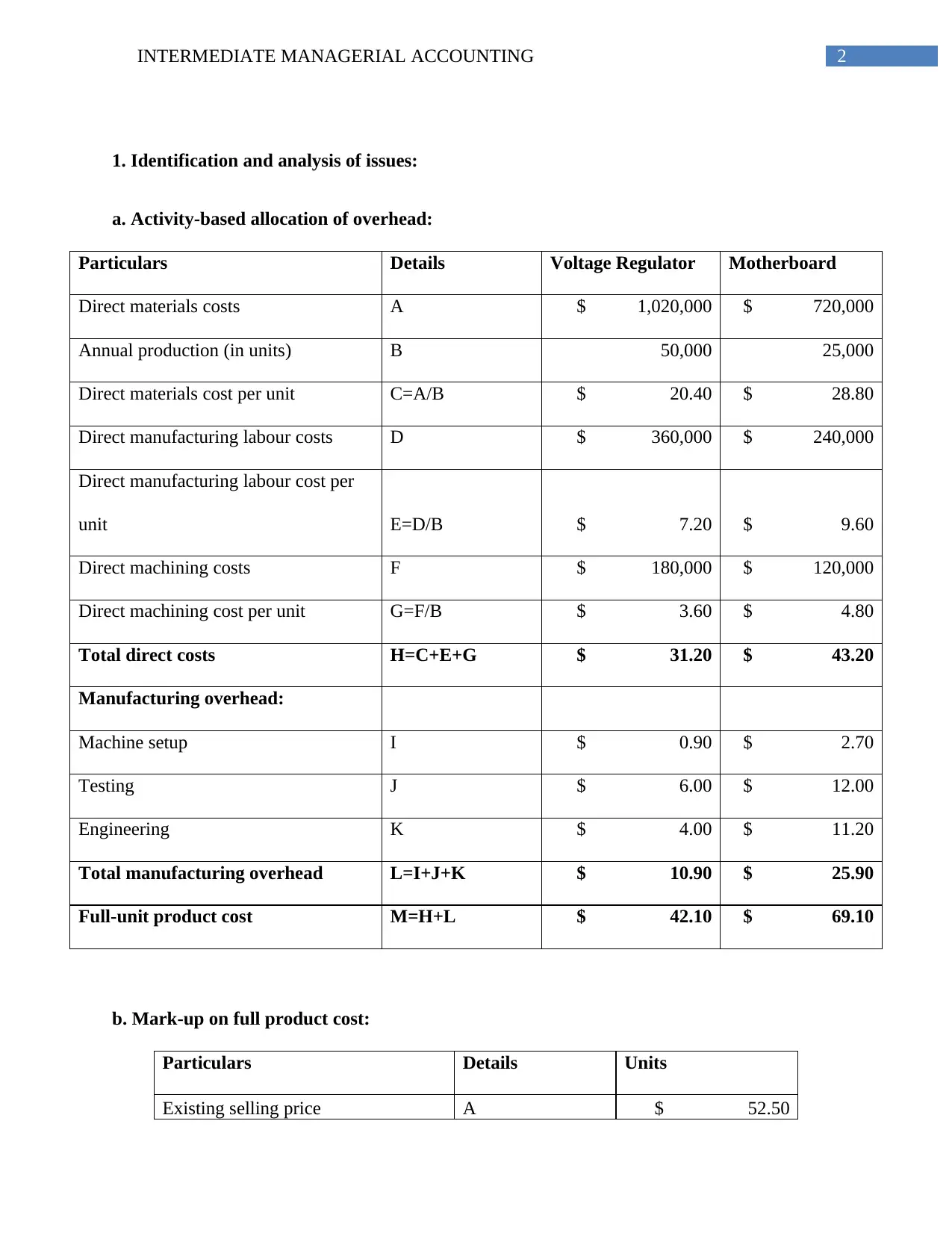
2INTERMEDIATE MANAGERIAL ACCOUNTING
1. Identification and analysis of issues:
a. Activity-based allocation of overhead:
Particulars Details Voltage Regulator Motherboard
Direct materials costs A $ 1,020,000 $ 720,000
Annual production (in units) B 50,000 25,000
Direct materials cost per unit C=A/B $ 20.40 $ 28.80
Direct manufacturing labour costs D $ 360,000 $ 240,000
Direct manufacturing labour cost per
unit E=D/B $ 7.20 $ 9.60
Direct machining costs F $ 180,000 $ 120,000
Direct machining cost per unit G=F/B $ 3.60 $ 4.80
Total direct costs H=C+E+G $ 31.20 $ 43.20
Manufacturing overhead:
Machine setup I $ 0.90 $ 2.70
Testing J $ 6.00 $ 12.00
Engineering K $ 4.00 $ 11.20
Total manufacturing overhead L=I+J+K $ 10.90 $ 25.90
Full-unit product cost M=H+L $ 42.10 $ 69.10
b. Mark-up on full product cost:
Particulars Details Units
Existing selling price A $ 52.50
1. Identification and analysis of issues:
a. Activity-based allocation of overhead:
Particulars Details Voltage Regulator Motherboard
Direct materials costs A $ 1,020,000 $ 720,000
Annual production (in units) B 50,000 25,000
Direct materials cost per unit C=A/B $ 20.40 $ 28.80
Direct manufacturing labour costs D $ 360,000 $ 240,000
Direct manufacturing labour cost per
unit E=D/B $ 7.20 $ 9.60
Direct machining costs F $ 180,000 $ 120,000
Direct machining cost per unit G=F/B $ 3.60 $ 4.80
Total direct costs H=C+E+G $ 31.20 $ 43.20
Manufacturing overhead:
Machine setup I $ 0.90 $ 2.70
Testing J $ 6.00 $ 12.00
Engineering K $ 4.00 $ 11.20
Total manufacturing overhead L=I+J+K $ 10.90 $ 25.90
Full-unit product cost M=H+L $ 42.10 $ 69.10
b. Mark-up on full product cost:
Particulars Details Units
Existing selling price A $ 52.50
⊘ This is a preview!⊘
Do you want full access?
Subscribe today to unlock all pages.

Trusted by 1+ million students worldwide
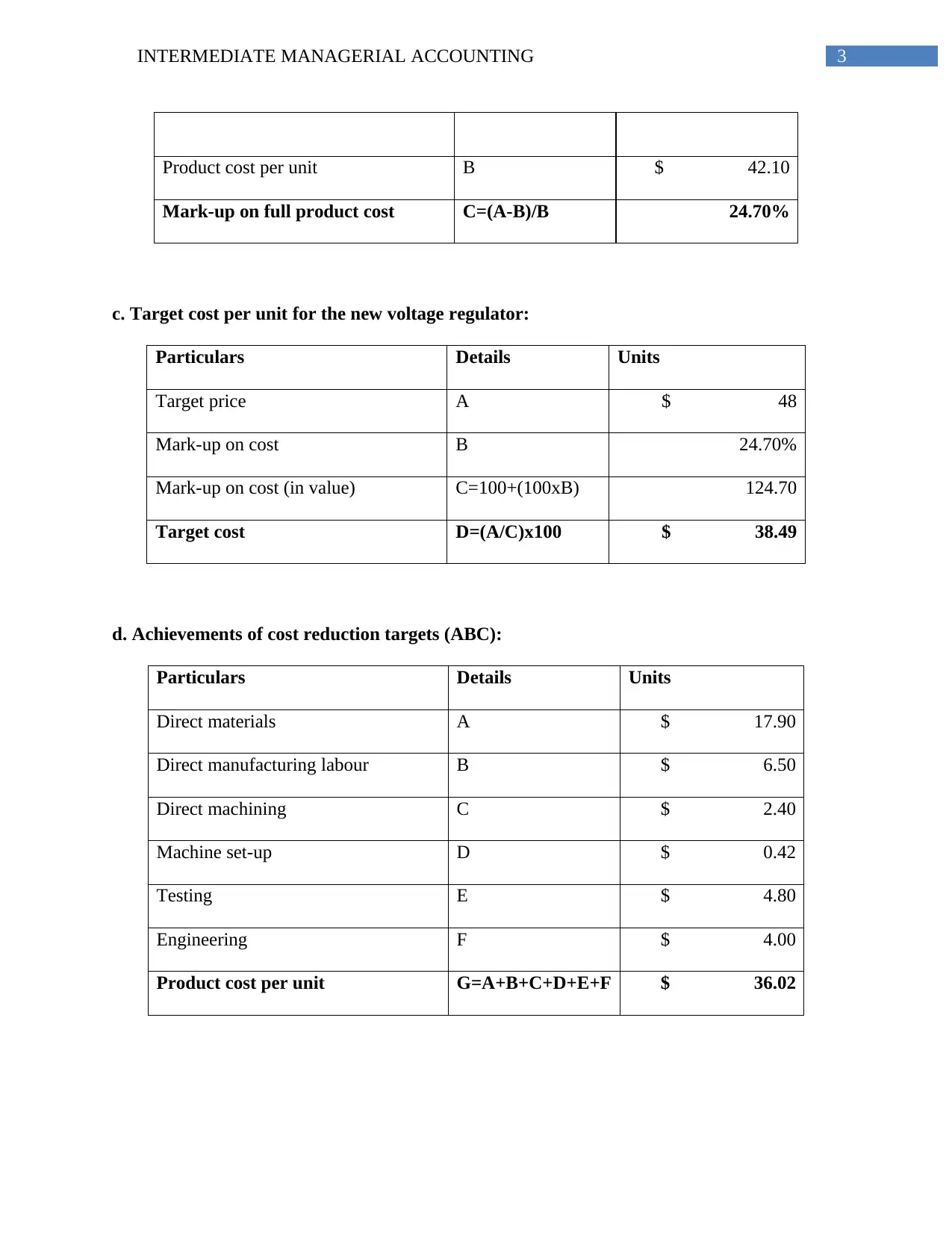
3INTERMEDIATE MANAGERIAL ACCOUNTING
Product cost per unit B $ 42.10
Mark-up on full product cost C=(A-B)/B 24.70%
c. Target cost per unit for the new voltage regulator:
Particulars Details Units
Target price A $ 48
Mark-up on cost B 24.70%
Mark-up on cost (in value) C=100+(100xB) 124.70
Target cost D=(A/C)x100 $ 38.49
d. Achievements of cost reduction targets (ABC):
Particulars Details Units
Direct materials A $ 17.90
Direct manufacturing labour B $ 6.50
Direct machining C $ 2.40
Machine set-up D $ 0.42
Testing E $ 4.80
Engineering F $ 4.00
Product cost per unit G=A+B+C+D+E+F $ 36.02
Product cost per unit B $ 42.10
Mark-up on full product cost C=(A-B)/B 24.70%
c. Target cost per unit for the new voltage regulator:
Particulars Details Units
Target price A $ 48
Mark-up on cost B 24.70%
Mark-up on cost (in value) C=100+(100xB) 124.70
Target cost D=(A/C)x100 $ 38.49
d. Achievements of cost reduction targets (ABC):
Particulars Details Units
Direct materials A $ 17.90
Direct manufacturing labour B $ 6.50
Direct machining C $ 2.40
Machine set-up D $ 0.42
Testing E $ 4.80
Engineering F $ 4.00
Product cost per unit G=A+B+C+D+E+F $ 36.02
Paraphrase This Document
Need a fresh take? Get an instant paraphrase of this document with our AI Paraphraser
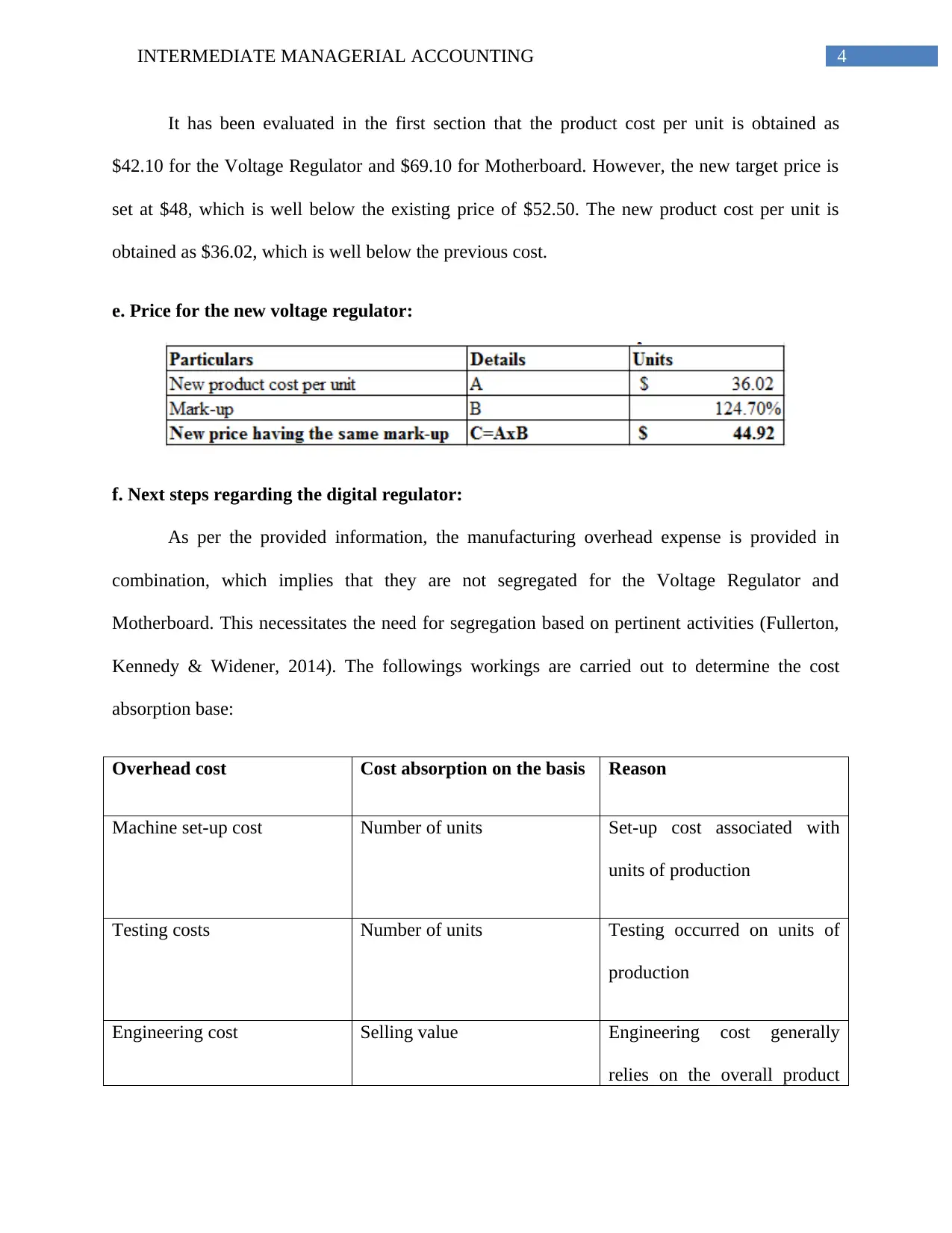
4INTERMEDIATE MANAGERIAL ACCOUNTING
It has been evaluated in the first section that the product cost per unit is obtained as
$42.10 for the Voltage Regulator and $69.10 for Motherboard. However, the new target price is
set at $48, which is well below the existing price of $52.50. The new product cost per unit is
obtained as $36.02, which is well below the previous cost.
e. Price for the new voltage regulator:
f. Next steps regarding the digital regulator:
As per the provided information, the manufacturing overhead expense is provided in
combination, which implies that they are not segregated for the Voltage Regulator and
Motherboard. This necessitates the need for segregation based on pertinent activities (Fullerton,
Kennedy & Widener, 2014). The followings workings are carried out to determine the cost
absorption base:
Overhead cost Cost absorption on the basis Reason
Machine set-up cost Number of units Set-up cost associated with
units of production
Testing costs Number of units Testing occurred on units of
production
Engineering cost Selling value Engineering cost generally
relies on the overall product
It has been evaluated in the first section that the product cost per unit is obtained as
$42.10 for the Voltage Regulator and $69.10 for Motherboard. However, the new target price is
set at $48, which is well below the existing price of $52.50. The new product cost per unit is
obtained as $36.02, which is well below the previous cost.
e. Price for the new voltage regulator:
f. Next steps regarding the digital regulator:
As per the provided information, the manufacturing overhead expense is provided in
combination, which implies that they are not segregated for the Voltage Regulator and
Motherboard. This necessitates the need for segregation based on pertinent activities (Fullerton,
Kennedy & Widener, 2014). The followings workings are carried out to determine the cost
absorption base:
Overhead cost Cost absorption on the basis Reason
Machine set-up cost Number of units Set-up cost associated with
units of production
Testing costs Number of units Testing occurred on units of
production
Engineering cost Selling value Engineering cost generally
relies on the overall product
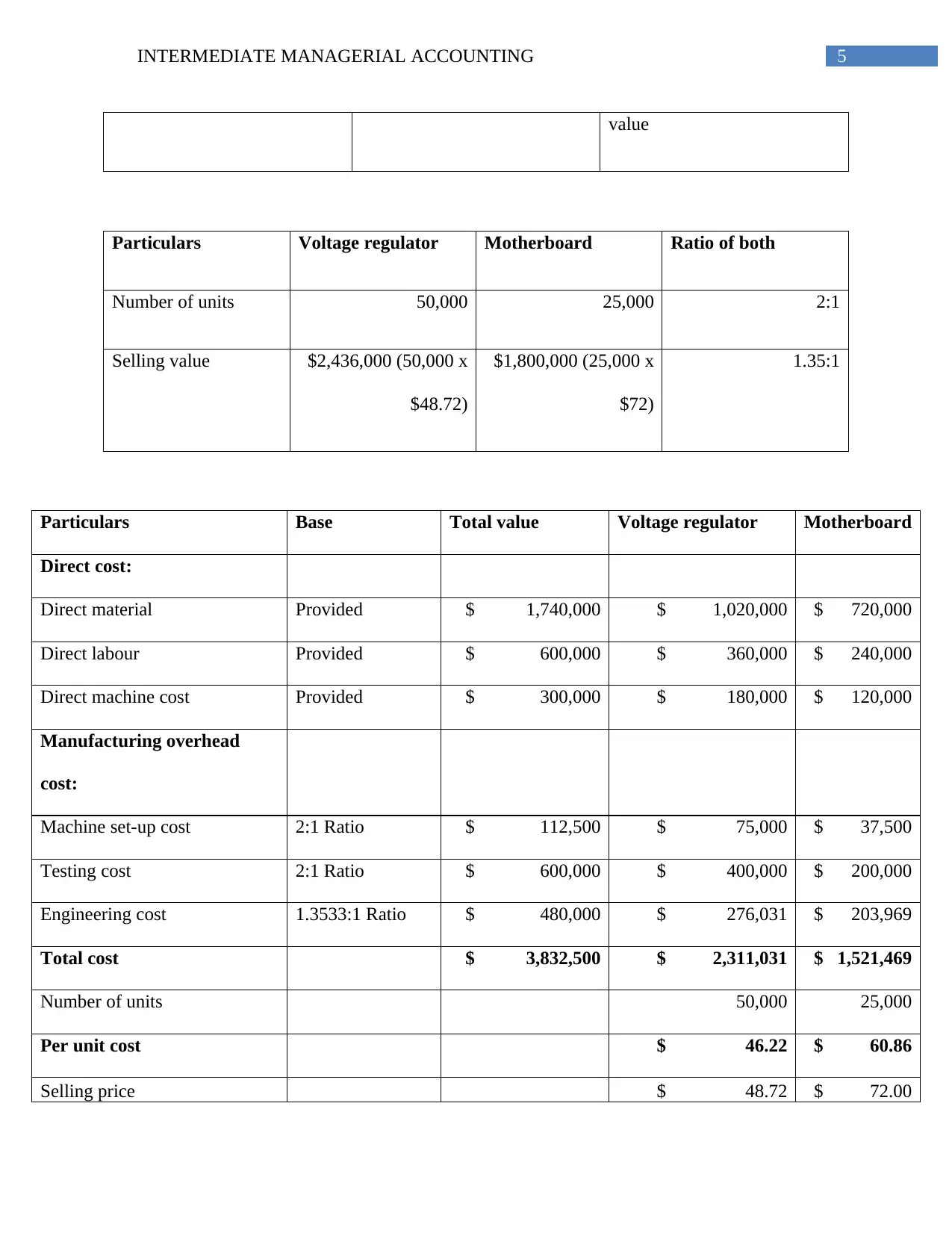
5INTERMEDIATE MANAGERIAL ACCOUNTING
value
Particulars Voltage regulator Motherboard Ratio of both
Number of units 50,000 25,000 2:1
Selling value $2,436,000 (50,000 x
$48.72)
$1,800,000 (25,000 x
$72)
1.35:1
Particulars Base Total value Voltage regulator Motherboard
Direct cost:
Direct material Provided $ 1,740,000 $ 1,020,000 $ 720,000
Direct labour Provided $ 600,000 $ 360,000 $ 240,000
Direct machine cost Provided $ 300,000 $ 180,000 $ 120,000
Manufacturing overhead
cost:
Machine set-up cost 2:1 Ratio $ 112,500 $ 75,000 $ 37,500
Testing cost 2:1 Ratio $ 600,000 $ 400,000 $ 200,000
Engineering cost 1.3533:1 Ratio $ 480,000 $ 276,031 $ 203,969
Total cost $ 3,832,500 $ 2,311,031 $ 1,521,469
Number of units 50,000 25,000
Per unit cost $ 46.22 $ 60.86
Selling price $ 48.72 $ 72.00
value
Particulars Voltage regulator Motherboard Ratio of both
Number of units 50,000 25,000 2:1
Selling value $2,436,000 (50,000 x
$48.72)
$1,800,000 (25,000 x
$72)
1.35:1
Particulars Base Total value Voltage regulator Motherboard
Direct cost:
Direct material Provided $ 1,740,000 $ 1,020,000 $ 720,000
Direct labour Provided $ 600,000 $ 360,000 $ 240,000
Direct machine cost Provided $ 300,000 $ 180,000 $ 120,000
Manufacturing overhead
cost:
Machine set-up cost 2:1 Ratio $ 112,500 $ 75,000 $ 37,500
Testing cost 2:1 Ratio $ 600,000 $ 400,000 $ 200,000
Engineering cost 1.3533:1 Ratio $ 480,000 $ 276,031 $ 203,969
Total cost $ 3,832,500 $ 2,311,031 $ 1,521,469
Number of units 50,000 25,000
Per unit cost $ 46.22 $ 60.86
Selling price $ 48.72 $ 72.00
⊘ This is a preview!⊘
Do you want full access?
Subscribe today to unlock all pages.

Trusted by 1+ million students worldwide
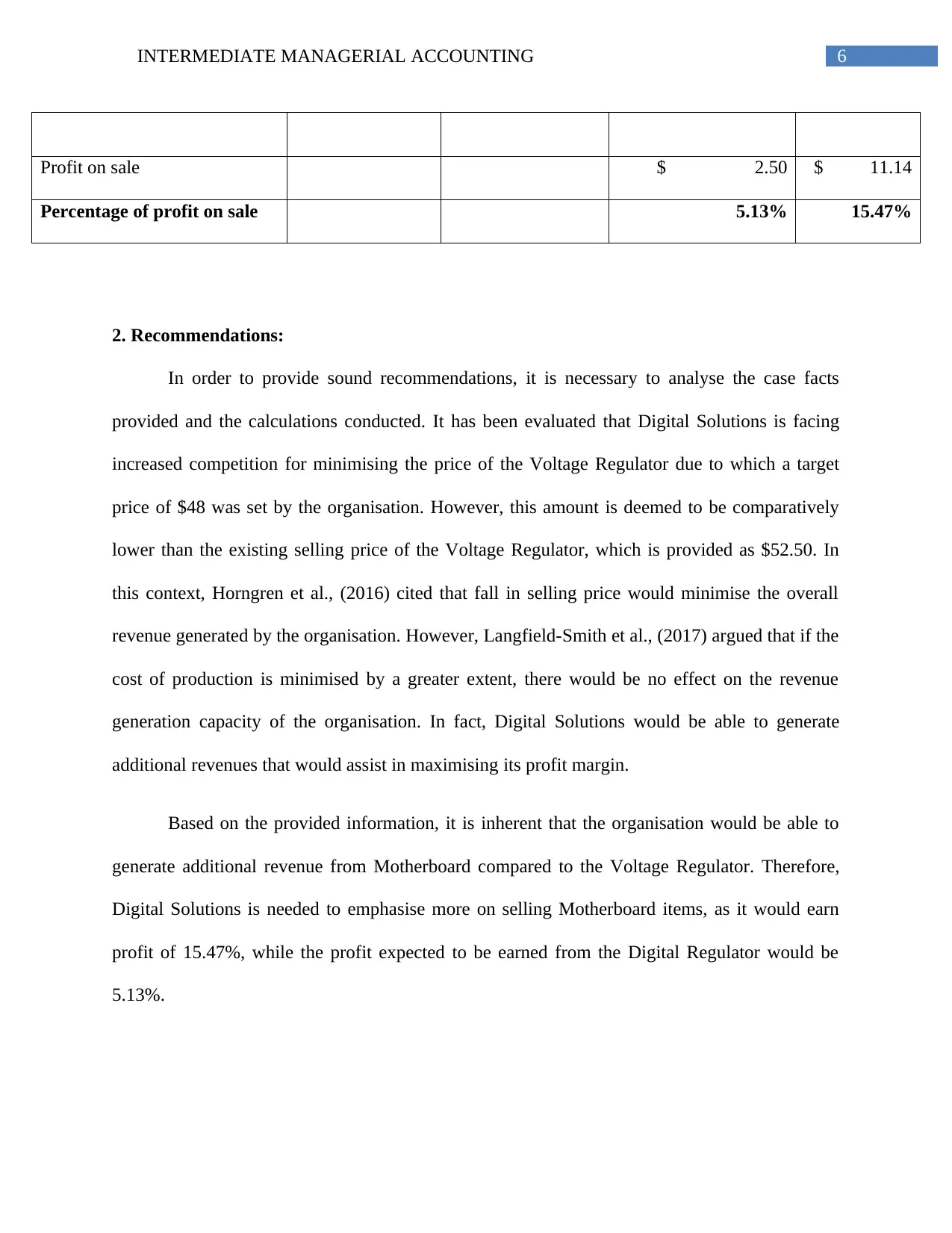
6INTERMEDIATE MANAGERIAL ACCOUNTING
Profit on sale $ 2.50 $ 11.14
Percentage of profit on sale 5.13% 15.47%
2. Recommendations:
In order to provide sound recommendations, it is necessary to analyse the case facts
provided and the calculations conducted. It has been evaluated that Digital Solutions is facing
increased competition for minimising the price of the Voltage Regulator due to which a target
price of $48 was set by the organisation. However, this amount is deemed to be comparatively
lower than the existing selling price of the Voltage Regulator, which is provided as $52.50. In
this context, Horngren et al., (2016) cited that fall in selling price would minimise the overall
revenue generated by the organisation. However, Langfield-Smith et al., (2017) argued that if the
cost of production is minimised by a greater extent, there would be no effect on the revenue
generation capacity of the organisation. In fact, Digital Solutions would be able to generate
additional revenues that would assist in maximising its profit margin.
Based on the provided information, it is inherent that the organisation would be able to
generate additional revenue from Motherboard compared to the Voltage Regulator. Therefore,
Digital Solutions is needed to emphasise more on selling Motherboard items, as it would earn
profit of 15.47%, while the profit expected to be earned from the Digital Regulator would be
5.13%.
Profit on sale $ 2.50 $ 11.14
Percentage of profit on sale 5.13% 15.47%
2. Recommendations:
In order to provide sound recommendations, it is necessary to analyse the case facts
provided and the calculations conducted. It has been evaluated that Digital Solutions is facing
increased competition for minimising the price of the Voltage Regulator due to which a target
price of $48 was set by the organisation. However, this amount is deemed to be comparatively
lower than the existing selling price of the Voltage Regulator, which is provided as $52.50. In
this context, Horngren et al., (2016) cited that fall in selling price would minimise the overall
revenue generated by the organisation. However, Langfield-Smith et al., (2017) argued that if the
cost of production is minimised by a greater extent, there would be no effect on the revenue
generation capacity of the organisation. In fact, Digital Solutions would be able to generate
additional revenues that would assist in maximising its profit margin.
Based on the provided information, it is inherent that the organisation would be able to
generate additional revenue from Motherboard compared to the Voltage Regulator. Therefore,
Digital Solutions is needed to emphasise more on selling Motherboard items, as it would earn
profit of 15.47%, while the profit expected to be earned from the Digital Regulator would be
5.13%.
Paraphrase This Document
Need a fresh take? Get an instant paraphrase of this document with our AI Paraphraser
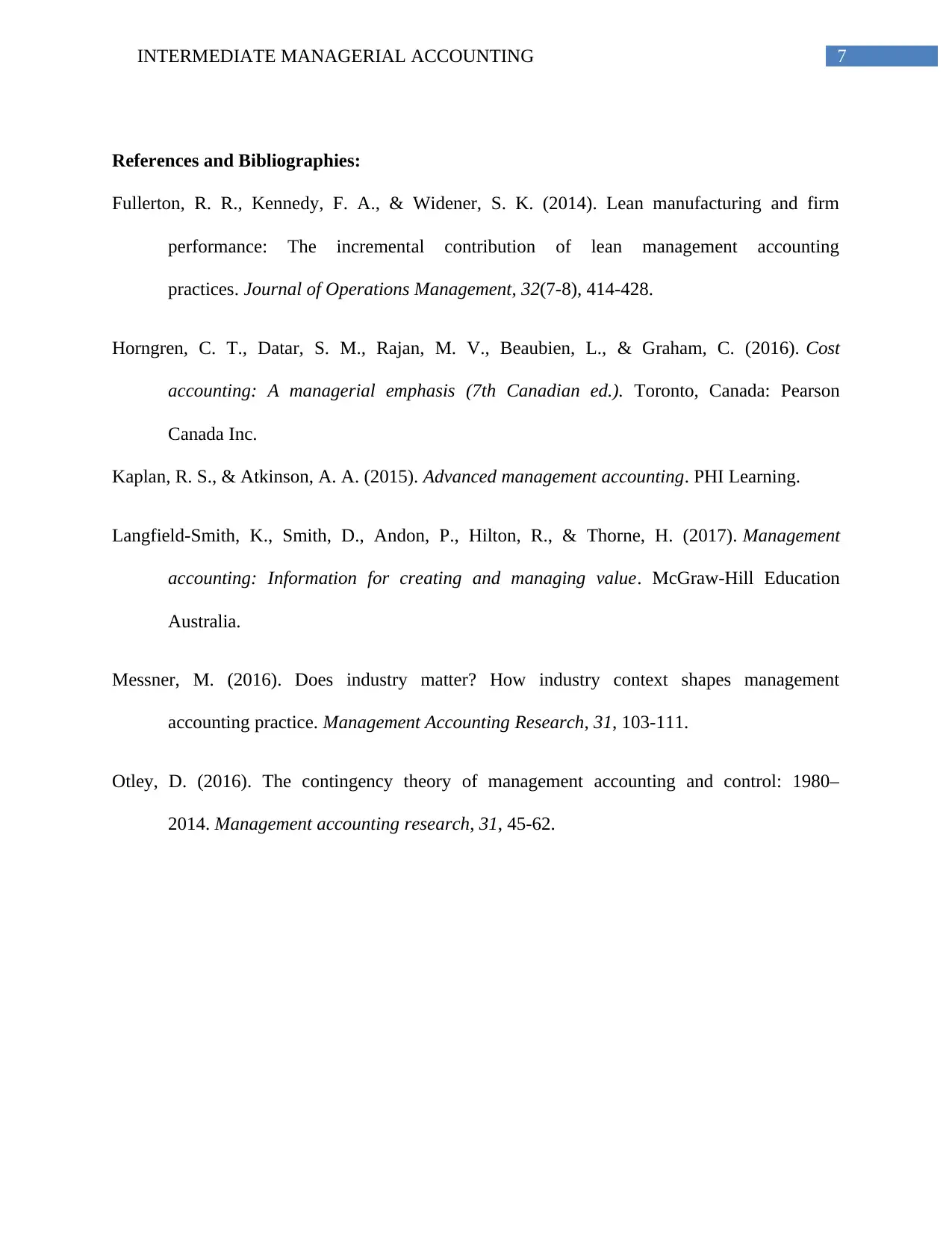
7INTERMEDIATE MANAGERIAL ACCOUNTING
References and Bibliographies:
Fullerton, R. R., Kennedy, F. A., & Widener, S. K. (2014). Lean manufacturing and firm
performance: The incremental contribution of lean management accounting
practices. Journal of Operations Management, 32(7-8), 414-428.
Horngren, C. T., Datar, S. M., Rajan, M. V., Beaubien, L., & Graham, C. (2016). Cost
accounting: A managerial emphasis (7th Canadian ed.). Toronto, Canada: Pearson
Canada Inc.
Kaplan, R. S., & Atkinson, A. A. (2015). Advanced management accounting. PHI Learning.
Langfield-Smith, K., Smith, D., Andon, P., Hilton, R., & Thorne, H. (2017). Management
accounting: Information for creating and managing value. McGraw-Hill Education
Australia.
Messner, M. (2016). Does industry matter? How industry context shapes management
accounting practice. Management Accounting Research, 31, 103-111.
Otley, D. (2016). The contingency theory of management accounting and control: 1980–
2014. Management accounting research, 31, 45-62.
References and Bibliographies:
Fullerton, R. R., Kennedy, F. A., & Widener, S. K. (2014). Lean manufacturing and firm
performance: The incremental contribution of lean management accounting
practices. Journal of Operations Management, 32(7-8), 414-428.
Horngren, C. T., Datar, S. M., Rajan, M. V., Beaubien, L., & Graham, C. (2016). Cost
accounting: A managerial emphasis (7th Canadian ed.). Toronto, Canada: Pearson
Canada Inc.
Kaplan, R. S., & Atkinson, A. A. (2015). Advanced management accounting. PHI Learning.
Langfield-Smith, K., Smith, D., Andon, P., Hilton, R., & Thorne, H. (2017). Management
accounting: Information for creating and managing value. McGraw-Hill Education
Australia.
Messner, M. (2016). Does industry matter? How industry context shapes management
accounting practice. Management Accounting Research, 31, 103-111.
Otley, D. (2016). The contingency theory of management accounting and control: 1980–
2014. Management accounting research, 31, 45-62.
1 out of 8
Related Documents
Your All-in-One AI-Powered Toolkit for Academic Success.
+13062052269
info@desklib.com
Available 24*7 on WhatsApp / Email
![[object Object]](/_next/static/media/star-bottom.7253800d.svg)
Unlock your academic potential
Copyright © 2020–2025 A2Z Services. All Rights Reserved. Developed and managed by ZUCOL.





